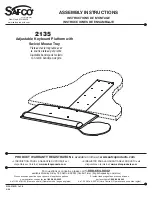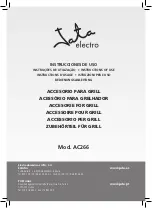
7 - Appendix
SMPTE Background
E-MU 1820M/1820/1212M PCI Digital Audio System
121
Duplicating SMPTE time code
The Sync Daughter Card always generates clean SMPTE from the SMPTE output when
reading SMPTE in. This time code is in sync with the incoming SMPTE and can be used
to feed other devices in your studio or to clean up old SMPTE tracks. Copying SMPTE
code from track to track produces deterioration of the signal with each generation,
although one generation of dubbing will probably be OK.
Other Tips for using SMPTE
1.
Use ascending time code.
Jumps in the code are OK as long as the SMPTE code
jumps forward in time as the tape moves forward in time. A good way to avoid any
problems with this is to simply stripe the entire project with SMPTE before you
record any other tracks.
2.
Allow enough leader.
Leave a few seconds between each song to allow SMPTE to
sync up before the song starts.
Keep written logs. Keeping written records of song start points and edit cues can save
time and avoid wasteful searching through a project that was recorded earlier.
Example SMPTE Connection
In the diagram below, Cubase is controlling the entire system by sending MTC to the
Sync Card which converts MTC to SMPTE. SMPTE is fed to the ADAT/BRC to convey the
absolute time information (hours-minutes-seconds-frames). ADAT/BRC is the word
clock master, controlling the Digital Audio System either through the embedded clock
in the ADAT optical stream or using word clock.
The Sync Card should not be used as both the SMPTE and word clock master.
Word
Clock is generated by the Digital Audio System and NOT by the software application
(Cubase). SMPTE is not locked to Word Clock inside the Sync Card—they are
completely independent.
SYNC
CARD
1010
CARD
ADAT Optical
carries embedded
word clock
ADOCK
ADAT
In
LTC
BRC
ADAT
REWIND
FAST FWD
STOP
PLAY
RECORD
EJECT
MTC
PatchMix DSP set to
ADAT Sync
1
33
65
97
2
34
66
98
3
35
67
99
4
36
68
100
5
37
69
101
6
38
70
102
7
39
71
103
8
40
72
104
RECORD
INPUT
9
41
73
105
10
42
74
106
11
43
75
107
12
44
76
108
13
45
77
109
14
46
78
110
15
47
79
111
16
48
80
112
RECORD
INPUT
17
49
81
113
18
50
82
114
19
51
83
115
20
52
84
116
21
53
85
117
22
54
86
118
23
55
87
119
24
56
88
120
RECORD
INPUT
25
57
89
121
26
58
90
122
27
59
91
123
28
60
92
124
29
61
93
125
30
62
94
126
31
63
95
127
32
64
96
128
RECORD
INPUT
TRACK 1-32
TRACK 33-64
TRACK 65-96
TRACK 97-128
AUTO INPUT
ALL SAFE
ALL INPUT
ALL CLEAR
GROUP 1
GROUP 2
GROUP 3
GROUP 4
SET GROUP
LOCATE
SET LOCATE
LOCATE 0
SET LOCATELOCATE SONG
LOAD SETUP
FROM TAPE
COPY SONGDELETE SONG
SAVE SETUP
TO TAPE
MIDI UTIL
PITCH MODE
PITCH DOWN
PITCH UP
NAME
SMPTE IN
MIDI IN
FIXED
VARIABLE
HOURS
MINUTES SECONDS FRAMES
CENTS
PITCH MODE
PITCH CONTROL
TAPE LOCATION
CURSOR
AUTO-PUNCH
SMPTE
SMPTE START
OFFSET
EXT SYNC
DISPLAY MODE RESET 0
FORMAT TAPE
DISPLAY TYPE
EJECT
PRE-ROLL
POST-ROLL
LOOP
TAPE OFFSETTRACK DELAY
DIGITAL I/O
AUTO PLAY
REHEARSE
GEN SYNC
EDIT
COPY TAPE
LOCATION
7
STUV
8
WXYZ
0
(CHARS)
4
JKL
5
MNO
6
PQR
1
ABC
2
DEF
3
GHI
TEMPO MAP
RECORD XFADE
NORMAL
SMPTE
BARS
BARS
BEATS
SUB BEATS
ABSOLUTE
RELATIVEE
DROP FRAME
30 FPS
29.97 FPS
25 FPS
24 FPS
M A S T E R R E M O T E C O N T R O L
R E C O R D
P L A Y
S T O P
F A S T F O R W A R D
R E W I N D
ADAT 9-pin
optional
if ADAT
sync isn't
used
Cubase
Summary of Contents for 1212M
Page 1: ...1820 1820 Owner s Manual Owner s Manual ...
Page 8: ...8 E MU 1820M 1820 1212M PCI Digital Audio System ...
Page 54: ...4 The PatchMix DSP Mixer Main Section 54 Creative Professional ...
Page 110: ...5 Effects E MU E Wire VST 110 Creative Professional ...
Page 116: ...6 Using High Sample Rates Overview 116 Creative Professional ...
Page 138: ...7 Appendix Internet References 138 Creative Professional ...















































